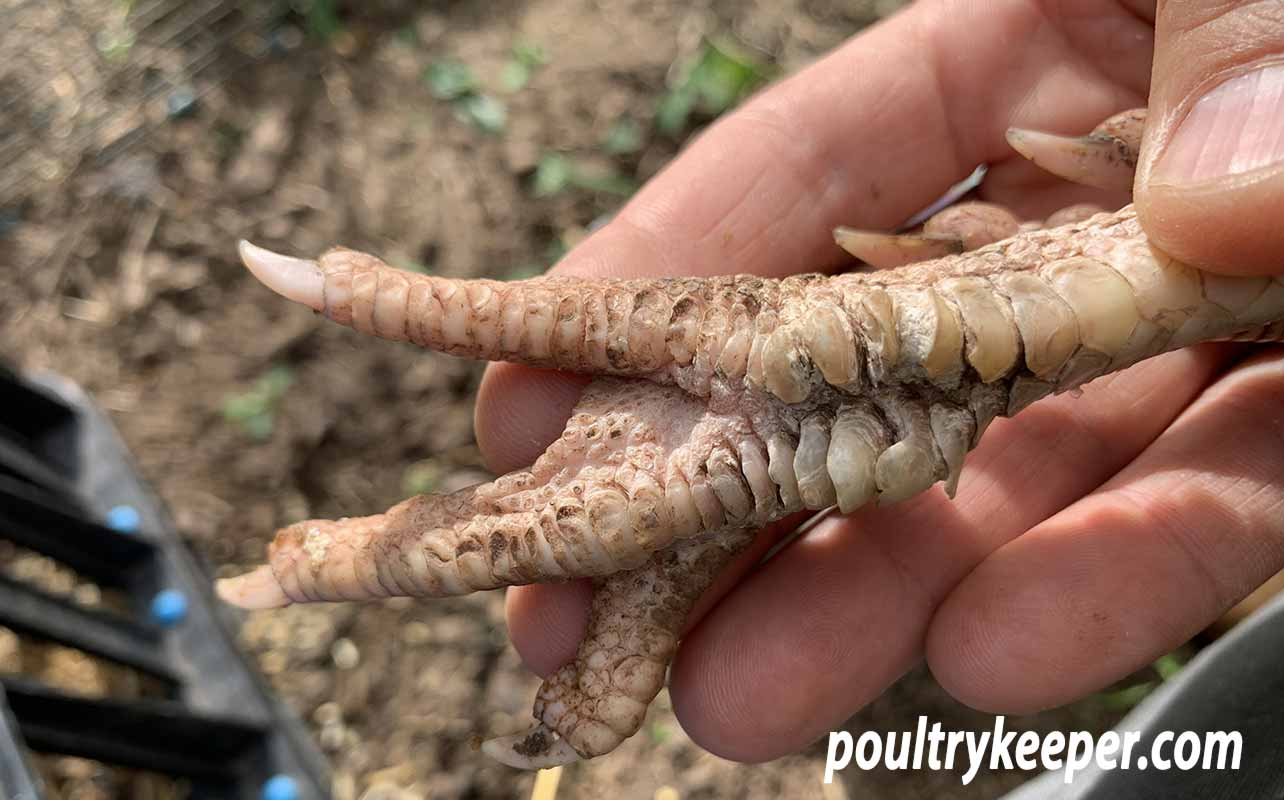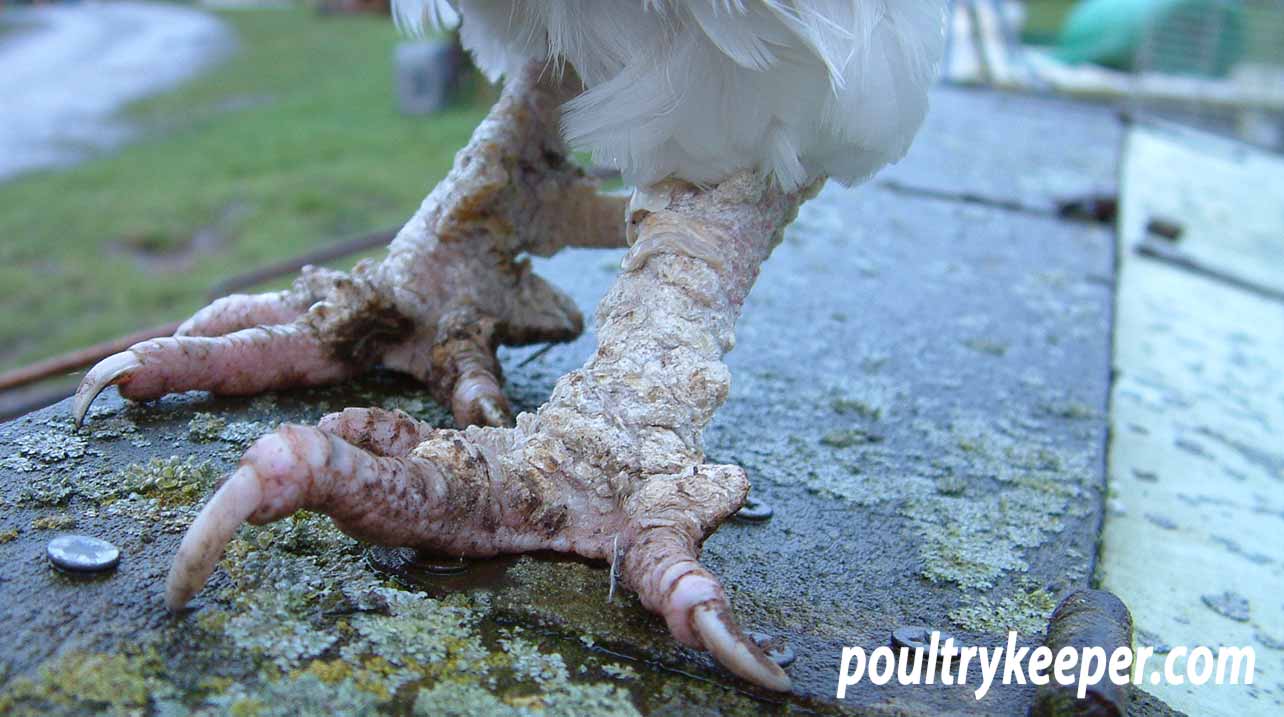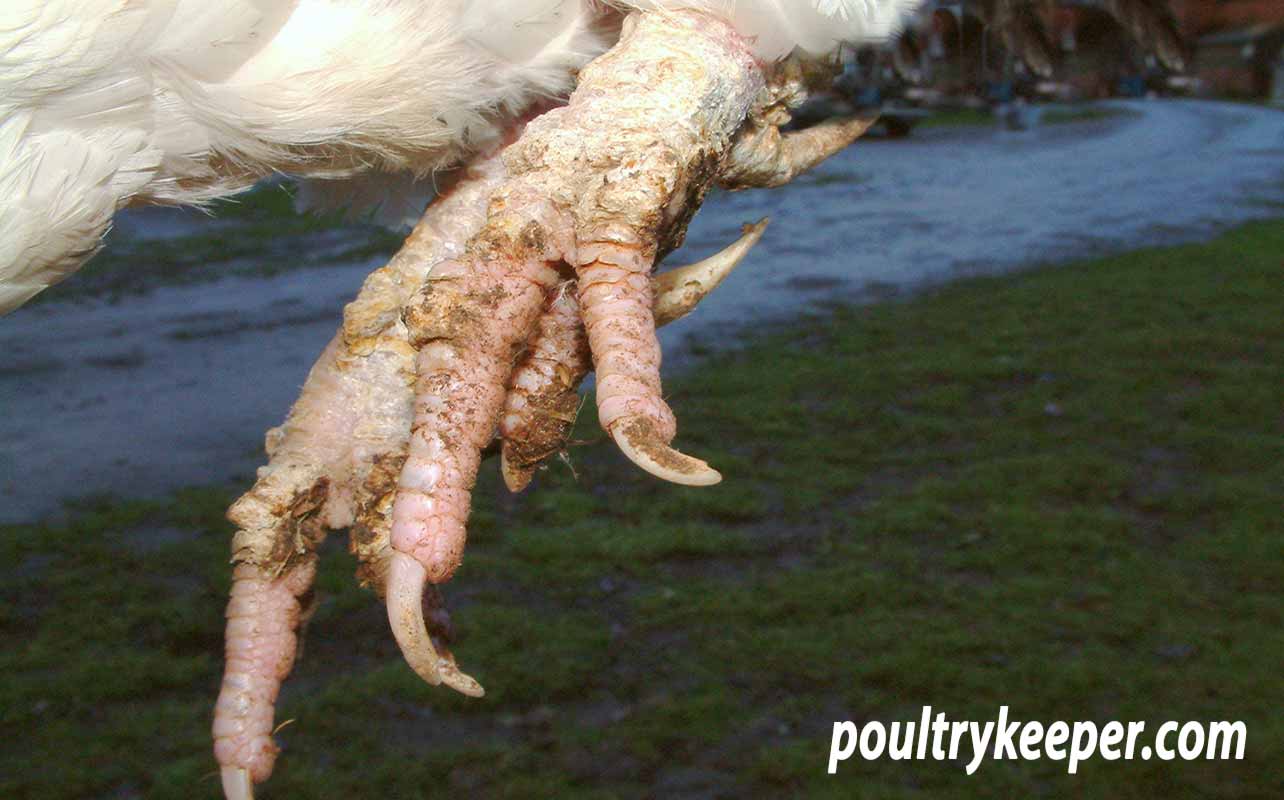
Scaly Leg Mite is caused by a burrowing mite (Knemidocoptes mutans) which causes scaly, raised encrusted scales on the legs of chickens and other poultry that have scales on their legs and feet.
The scaly leg mites can cause intense irritation to the bird by burrowing under the scales to feed on the keratin beneath. They cause the scales on the legs and feet to become raised and thicken and the keratin to ouze out and turn crusty. These mites are relatively common in backyard flocks.
The scales often look like they protrude outwards, and parts of the scales will come off, making the legs look unsightly. Scales should never be picked or cut off as this will damage the legs. Birds need treatment to kill the mites, and their scales are left to come away naturally during a moult. It can take up to 12 months before the scales have moulted and regrown to look normal again.
Symptoms of scaly leg mites
Scaly leg mites symptoms are easy to spot. Knemidocoptes mutans or scaley leg mites are a mite that burrows under the scales so they cause scaly, raised encrusted scales on the legs of chickens and other poultry. Waterfowl do not suffer from scaly leg mites because their legs and webs do not have scales.

Prevention
Scaly leg mites are spread by direct contact with other birds. The mite spends its entire life cycle on the bird.
You can prevent this mite from spreading with good biosecurity, being careful not to bring new birds in that are carriers.
Although I hatch most of my replacement pure-breed chickens, I occasionally buy some ex-battery hens or hybrid pullets, which are better egg layers than the pure breeds. I quarantine them for 2-3 weeks before adding them to my flock. During this time, they can be checked over and monitored for signs of ill-health.
Ectoparasites
Scaly leg mites are called an ectoparasite because they live on the outside of the bird's body. Here are some other common ectoparasites you may come across in backyard flocks.
- Red Mites - Found in cracks of the poultry house, crawling onto your birds for a feed while they roost at night.
- Northern Fowl Mites -Dark brown and often found around the vent and ear canals.
- Lice -Fast moving and up to 4mm long, found crawling at the base of the feathers.
Treatment
Treating scaly leg mites is relatively straightforward. To treat scaly leg, it can take several repeated treatments, which can be time-consuming unless you choose to use medication to kill the mites.
These are the two chicken scaly leg mites treatments commonly used:
Using Vaseline and surgical spirit
- Use Vaseline (Petroleum Jelly) to soften the scales rubbed into the legs or wash with baby shampoo and scrub legs with a small brush like a toothbrush.
- To kill the scaly leg mites, dip legs into surgical spirit once per week for 3 to 4 weeks. Vaseline rubbed in between treatments also helps to suffocate the mite.
This treatment was suggested in Victoria Roberts Diseases of Free Range Poultry book.
Vaseline is a petroleum-based product and considering petroleum is toxic to poultry, I wondered if it was safe.
Vaseline is a blend of mineral oils and waxes and used for skin care. It undergoes a triple purification process to remove impurities, resulting in a non-irritating and hypo-allergenic jelly. There is more information on the Vaseline FAQ page.
Meanwhile, the surgical spirit is an antiseptic for wounds and a disinfectant that is often used to disinfect piercings, clean injuries, or sterilise skin before surgery.
Using Ivermectin
- An alternative scaly leg mite treatment is Ivermectin that kills mites. Ivermectin drops (dropped behind the neck or under the wing onto the skin) will kill scaly leg mites and common poultry worms. Some vets will prescribe this to kill the scaly leg mites but check with your vet first. Ivermectin is not licensed for use on chickens, although many people purchase Ivermectin drops that are intended for pigeons or cage birds.
- Do not pull off crusts. Scales on the legs can take up to a year to regrow and look normal again.
Ivermectin has been prescribed by vets for parasite problems in poultry for many years, however, it is not licensed for poultry in the UK, so to use it, you must have it prescribed by a vet under their clinical judgement.
The usual withdrawal period for eggs for a non-licensed medication is 7 days.
It is likely obtaining a license in food-producing animals in the UK is too costly since there is no commercial requirement for Ivermectin in egg layers or broiler production.
For humans, ivermectin tablets have been used to treat some parasitic worms, and there are topical skin treatments for some head lice and skin conditions.
Personally, I consider it relatively safe to use and will use Ivermectin for my chickens with a 7 day withdrawal period following the advice of my vet.
Many backyard poultry keepers in the UK will purchase Ivermectin drops marketed for use in pigeons or cage birds.
You can read more on my page about Ivermectin.

Beware:
There are suggestions on some websites to use Creosote, Diesel or Gasoline for scaly leg mites. These chemicals are not safe for your birds and I do not recommend this treatment. Also, remember that any chemical products you use on your chickens can leave residues in the eggs they lay.
Common questions
There is, unfortunately, a lot of inaccurate and poorly researched information and some myths circulating online.
Whilst I can’t find reliable references to answer every question, I have responded to a few below that might be helpful.
Scaly Leg Mite is caused by a burrowing mite (Knemidocoptes mutans). It spends its 10-14 day life cycle on the bird, but it can be passed around your flock when birds are in close contact.
The cause of infection is almost always an infected bird coming into the flock, perhaps new birds you have purchased, but occasionally it can be from wild birds.
Whilst there are many mites that can affect humans (and requires a specialist to diagnose), I have not found any evidence that Scaly Leg Mites can affect humans. They are not listed as zoonotic (a disease or parasite that has infected humans) in any veterinary book I have read.
I have found no reliable source of information to suggest it kills scaly leg mites, and from my own experiments, I believe the answer is no, Diatomaceous earth does not kill scaly leg mites.
It is a very useful natural product for killing lice and mites, and I have tried mixing it with a little cod liver oil to help it stick to the legs, repeating the treatment almost daily for a month.
Since the scaly leg mites have burrowed beneath the scales, I believe the Diatomaceous earth cannot get in contact with the mite so treatment has been ineffective.


